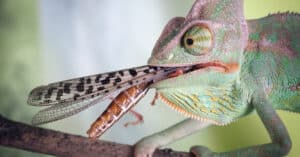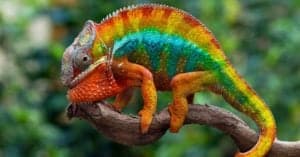Chameleons are reptiles that are part of the suborder Iguania. They are fascinating creatures as they can camouflage by changing their skin color to match their environment. However, male and female chameleons have different colors. Adult males have varying combinations of green, bright red, yellow, and blue, while female and young chameleons are tan-brown with bits of orange or pink.
Chameleons have unique feeding requirements, which make them difficult to care for compared to other exotic pets. To feed these creatures, you’d need to have crickets and worms (mealworms or wax worms) available. With this kind of diet, you might wonder how big chameleons get.
This article aims to bring you helpful information on how big they get.
How Big Do Chameleons Get?
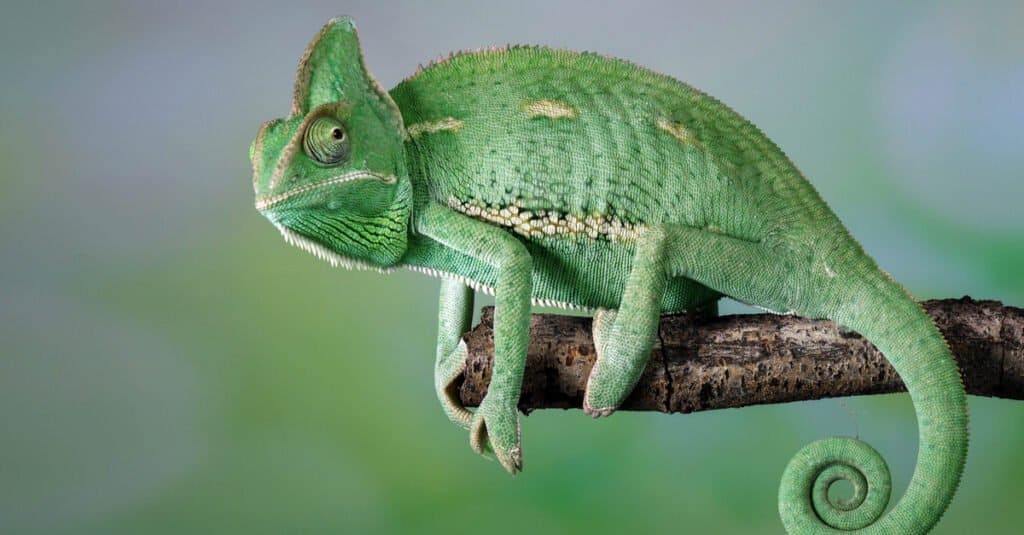
Male chameleons grow to 15-27 inches while females reach 10-14 inches.
©Lauren Suryanata/Shutterstock.com
Averagely, adult male chameleons grow about 15-27 inches long and weigh (depending on the species) as much as 180 grams (6.3 ounces). On the other hand, adult females grow up to about 10-14 inches long and can weigh up to 130 grams (4.6 ounces). When chameleons hatch, they are usually 4 inches long from the tip of their nose to their tail.
There are about 202 species of chameleons. But for this article, we will be comparing the sizes of just ten out of some of the most popular pet chameleons. Let’s explore!
Pygmy Chameleons
Pygmy chameleons are tiny ground-dwelling lizards that grow 3 to 4 inches long and weigh about an ounce. A single pygmy requires an aquarium of just about 5 gallons.
Senegal Chameleons
Senegal chameleons can grow and attain a size of 8 inches in length. They can live as long as five years, but the females who lay numerous clutches of eggs may not live as long as that.
The Flap Neck Chameleons
Flap neck chameleons are quite large, and they attain a length of around 14 inches (including tail).
Jackson Chameleons
Adult male Jackson’s chameleons are often about 9-13 inches long and weigh around 90 to 150 grams, while the average length of their adult females is about 7-8 inches, with their weight being around 90 to 130 grams.
The Carpet Chameleon
Overall, carpet chameleons grow from 10-14 inches in length, and they require an 18″×18″×36″ enclosure with branches.
The Fischer’s Chameleon
They are active and moderately sized animals that are often about 7.5 to 9.5 inches long. They also have unusually long tails that make up virtually half of their body length.
Veiled Chameleons
Their adult males are usually about 17-24 inches long and weigh up to 170 grams, while adult females are generally about 14 inches long on average and weigh around 85 to 113 grams.
Panther Chameleons
Adult male panther chameleons grow up to 14-21 inches and weigh around 140 to 180 grams, while the females rarely grow longer than 14 inches – they are usually between 9-13 inches long and weigh between 60 to 100 grams.
Meller’s Chameleons
Meller’s chameleons grow 18-24 inches long and may live up to 12 years in captivity.
Parson’s Chameleons
They are about 27 inches long, and at maturity, they weigh about 700g upwards.
How Long Does it Take a Chameleon to Get Big?
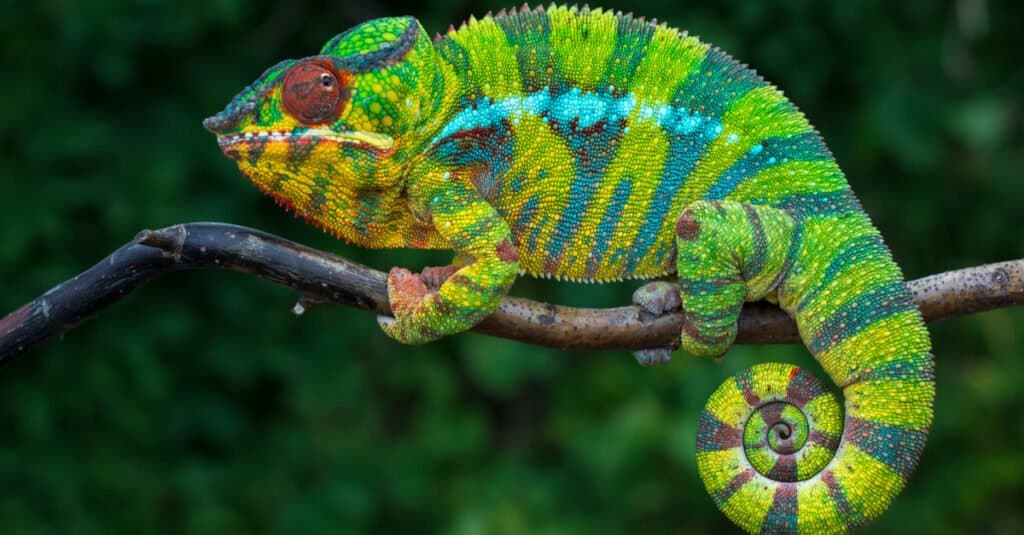
A chameleon attains its full size in 18 months.
©Jan Bures/Shutterstock.com
It takes chameleons about 18 months to attain their full size because they grow extremely rapidly. While babies, their growth rate is approximately an inch per week! Baby chameleons have utterly ravenous appetites, and they continue with that appetite for about a year. This implies that you will have to continue feeding them to meet their growing demands.
By the time they clock a year, they would already be close to their full size, and in another six months, they become full-fledged adults. Though it takes 18 months for most chameleons, their development is totally species-dependent.
The Largest and Smallest Chameleon Ever Recorded
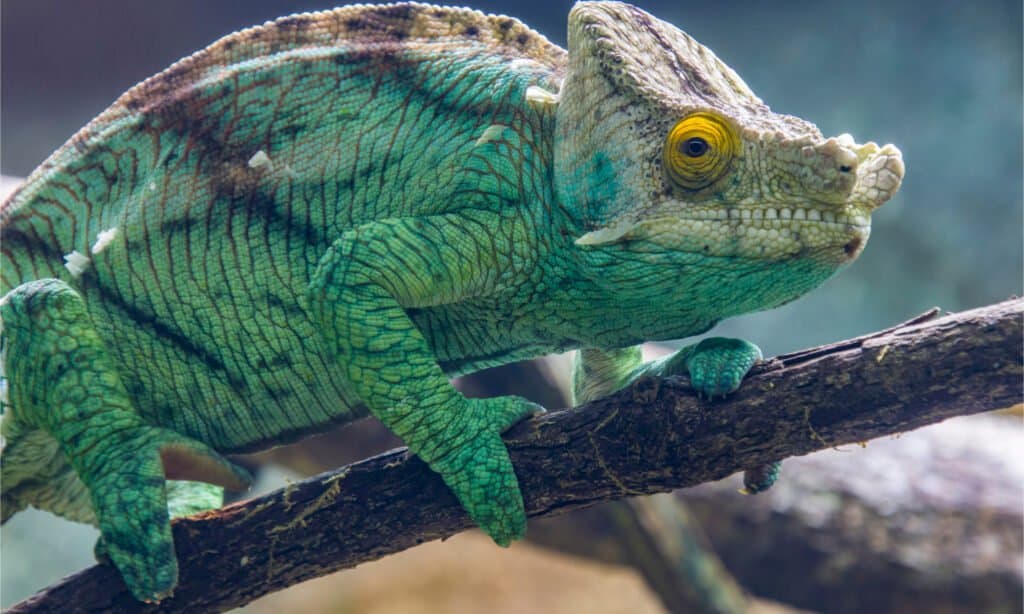
The Parson’s chameleon is the largest species of chameleon, reaching 27 inches long.
©Danny Ye/Shutterstock.com
The largest chameleon is the Parson’s chameleon which was found in the lush rainforests of Eastern and Northern Madagascar. It is up to 27 inches long.
The smallest chameleon is the Brookesia nana, also called nano-chameleon. It is just about 0.5-1 inch. It is also the smallest reptile discovered on Earth that can comfortably sit on the tip of a finger.
How to Ensure Maximum Growth of Your Chameleon
Chameleons are insectivores, meaning they mainly feed on insects. However, some have been found to eat rodents and small birds. Chameleons occasionally eat vegetables, fruits, and general foliage to supplement their diets and provide additional nutrition. Below are feeding practices to adopt to encourage the proper growth of your chameleon.
Feed them crickets
The most commonly purchased food for chameleons is crickets. Buy your crickets and feed your chameleon a few crickets at once. However, note that crickets don’t live long, so buy only a week or two weeks’ worth at a time.
If you decide to raise crickets or any other insect for your chameleon, ensure you feed them vegetables high in calcium and vitamin A. This is beneficial in terms of nutrients that help stimulate your chameleon’s mind.
Supplement other insects
Frequently supplement your chameleon’s diet with other insects such as mealworms, grasshoppers, flies, super worms, and moths. They would contribute to a well-balanced diet for your chameleon. However, avoid feeding your chameleon wasps, bees, fireflies, or other stinging insects.
Adequate Water
Water is also crucial to the health and growth of your chameleon. So always make water available.
Apart from genetics and the type of chameleon species, adequate feeding significantly contributes to how big your chameleon will get.
Are Chameleons Good Pets?

In the right circumstances, chameleons can make good pets.
©somsak mungmee/Shutterstock.com
Chameleons can make excellent pets in the right situations. But they are not the best choice for everybody because chameleons call for a specific care regimen with a hands-on policy. Hence, it’s up to you to decide whether or not to undertake such responsibilities.
The photo featured at the top of this post is © Jason Mintzer/Shutterstock.com
Thank you for reading! Have some feedback for us? Contact the AZ Animals editorial team.



